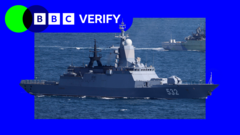Following severe damage to undersea power cables, Estonia has deployed a patrol boat to protect the Estlink 1 connection as NATO increases military support in the Baltic Sea. Both Estonia and Finland are investigating threats from a suspected "shadow fleet" of Russian vessels.
Estonia Strengthens Defense of Undersea Power Link Amid Sabotage Claims

Estonia Strengthens Defense of Undersea Power Link Amid Sabotage Claims
As tensions rise, Estonia's navy takes action to safeguard the Estlink 1 cable following alleged Russian attacks on critical undersea infrastructure.
The Estonian Navy has mobilized a patrol boat, the Raju, to protect its Estlink 1 undersea power cable after recent allegations of sabotage targeting critical infrastructure in the Gulf of Finland. NATO has announced plans to bolster its military presence in the Baltic Sea in response to these tensions. The oil tanker, identified as Eagle S, is under suspicion for damaging the Estlink 2 cable, leading to a steep reduction in Estonia's power supply.
Finnish authorities have intervened, boarding the Eagle S and bringing it into Finnish territorial waters as part of their investigation, which has been described as essential given the string of incidents affecting undersea cables in the region. The European Union has expressed concern, labeling the Eagle S as part of Russia's "shadow fleet," tying these incidents into a broader pattern of suspected attacks on critical infrastructure.
Estonian Defence Minister Hanno Pevkur confirmed the deployment of the Raju on Friday, emphasizing its mission to maintain the operational integrity of essential connections with Finland. It has been reported that Finland may also join Estonia in safeguarding the remaining cables. NATO Secretary General Mark Rutte communicated with Finnish President Alexander Stubb, discussing the possibilities of enhanced NATO presence.
The Estlink 2 cable, measuring 170 km (105 miles), remains out of commission, with repair estimates from Fingrid indicating it could remain inoperative until late July 2025. Notably, this incident marks the third significant undersea disturbance in just over a month, following previous damage to the Arelion and C-Lion 1 cables. Each case has raised alarms over potential state-sponsored sabotage, particularly as similar incidents involving Chinese ships have raised eyebrows.
In light of these developments, Estonian Prime Minister Kristen Michal urged a preemptive defensive stance, citing readiness to invoke Article 4 of the NATO Treaty if any member feels threatened. Meanwhile, Estonian energy firms have reassured the public regarding secure power supplies, acknowledging the limitations in monitoring vast underwater areas.
The EU is working on potential sanctions targeting Russia's shadow fleet which compromises regional security. Both the Yi Peng 3 and Eagle S are under scrutiny as they could play roles in Russia’s strategy of circumventing sanctions imposed due to its ongoing conflict in Ukraine.
With Finland and Estonia both NATO members, the recent escalation highlights the intricate dynamics at play in the security landscape of the Baltic Sea, amidst concerns over maintaining power supply and safeguarding vital undersea infrastructure.























